模联会议背景文件资料
- 格式:doc
- 大小:162.87 KB
- 文档页数:11
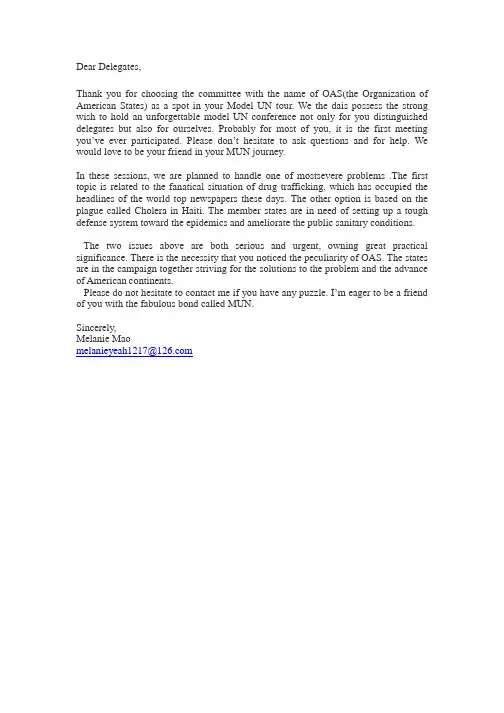
Dear Delegates,Thank you for choosing the committee with the name of OAS(the Organization of American States) as a spot in your Model UN tour. We the dais possess the strong wish to hold an unforgettable model UN conference not only for you distinguished delegates but also for ourselves. Probably for most of you, it is the first meeting you’ve ever participated. Please don’t hesitate to ask questions and for help. We would love to be your friend in your MUN journey.In these sessions, we are planned to handle one of mostsevere problems .The first topic is related to the fanatical situation of drug trafficking, which has occupied the headlines of the world top newspapers these days. The other option is based on the plague called Cholera in Haiti. The member states are in need of setting up a tough defense system toward the epidemics and ameliorate the public sanitary conditions.The two issues above are both serious and urgent, owning great practical significance. There is the necessity that you noticed the peculiarity of OAS. The states are in the campaign together striving for the solutions to the problem and the advance of American continents.Please do not hesitate to contact me if you have any puzzle. I’m eager to be a friend of you with the fabulous bond called MUN.Sincerely,Melanie Maomelanieyeah1217@Topic A: Drug TraffickingState of the ProblemNothing can be more complicated and fascinating than the topic related to drugs, especially the one which is now proceeding in a dramatic way in Latin America. Taking the lead of the produce and the sale of cocaine, the area of Latin America can’t avoid being involved in the issue of drug trafficking.Drug trafficking is the illegal production and distribution of controlled substances. It has profound and lasting impacts on many aspects of society,from the presence of gangs and gang-related violence to the effects of drug filthy money on the in the poor neighborhood.International drug traffickers deal mostly with large amount of goods and sell to dealers who distribute the goods for additional profit. There is a clear division of labour and benefit rational cooperation between the nations in Latin American. Moreover, US’s role as a lucrative market for illegal drugs has enticed those underdeveloped and public security confused countries habitants to take the risks. International organizations such as UNCND(the Commission on Narcotic Drugs) and regional organizations have never stopped their paces to control it. This includes offering financial and technical supports to Latin American countries in order to ensure them have the capability to face the narcoterrorism and the severe condition of drug cultivation.The traffickers realize the deal by building up concealed and countless tunnels in the border cities. Besides, the dealers have thought of more methods even as smuggling kids as the carriers and body stuffing which are obviously in conflict with humanitarian spirits.Drugs trafficking also leads to the instability of politics in the Latin America countries. The Mexican authorities have made attempts to strike drug trafficking by burning 134 tons of marijauna and reinforce the strength of police. But the truth that nearly 30,000 people have been killed with some association with the illicit trade can’t earn any points for the government of Mexico.As we have stated above, the drug trafficking problem expands its impacts onto the fields of security, politics, agriculture, sanitation, transportation and human rights. It is certain that the solution to the problem rely on the success of all areas and the cooperation which is tougher than traffickers’ between the states of America.History of the ProblemWhile drug trafficking has been around for one form or another, drug trafficking as it is recognized today became prominent starting in the 1960s. Since then, the process of drug enforcement has never been suspended.During the 1960s, with the confusion in terms of politics in Latin America, drugs like marijuana, amphetamines, and psychedelics came on the scene. Then the boom of drug black market exploded. Governments soon made swift response to it. Since the mid-1970s, the U.S. government has invested billions of dollars in anti-drug assistance programs aimed at reducing the flow of Latin American-sourced illicit drugs to the United States.There is a covering of Time Magazine in 1979 with the headline written - Colombia Connection, billions in pot & Coke. People in this article described Colombia as the paradise of the trafficker. It is believed that the smugglers generated a multi-billion-dollar black market.With time passed by, the improvement hasn’t been found out. With the contradiction and campaign becoming increasingly intense, the international organizations and the national governments took series of measures to eradicating the drug trafficking issues.However, things continued with the charm of potential profits and expand of the smuggling gangs. There is also a solid foundation which is well known as the drug cultivation. The link between cultivation and illicit trade has been set up and never seems to break down ever since.The notorious drug cartels entice the gang related violence in recent decades. The countries like Bolivia, Colombia, Chile have gained their independence in 1990s but fell into close anarchy. The opposition turned into gangs relying on the black benefits from smuggling drugs. The governments have been involved in the current of fighting against the gangs. However, the result was not satisfied at all.Though the international society criticized seriously about the ineffective measures taken by Latin America Nations, the matter still goes beyond control so that the pacification is absolutely needed in the fast developing era.Past actionsThe committee should stress the leading role of the United States in fighting against the drug trafficking. Being the grandest market of illicit drug trade, the USA government has never ceased its attempt at striking the traffickers and illegal dealers. In 1990s, the United States set at the Fumigation Programs in Bolivia and Peru. Nevertheless, the consequence proved to be dramatically. The dealers then subsidized the local farmers in Colombia on the cultivation of narcotic crops such as poppy.The amount of seized drugs of the USA accumulated. But as its behavior in the Viet Nam War, it is regarded as the unrealistic index. America’s role in managing drug trafficking has been extensively recognized to be a kind of interference. Despite the accumulating fund put into Drug War since president Ronald Reagan, it seems that USA is still alone in serious fight due to the corruption of the government in Latin America countries.The urgency of problem has surely aroused the eyeballs of Latin American Nations. Accordingly, the Caribbean and Central America area has set up the center to strike the rampant narcotics related crimes. The conferences are quite frequent and release practical resolution as well. The government has acknowledged the essence of increasing information and intelligence communication. It brought a good start to continental cooperation. The severe condition changed the country formation to some extent. Take Colombia as an example, the power of Police has been converted into certain military force in order to fight against the gangs. The gangsters possessed well equipped private army which will definitely resist the mediocre force from the police. The active part that we American nations take in UNODC has revealed the eagerness in striking narcotics trafficking. Immediate legislation together with countless pieces of resolution.Synchronized manner on multiple fronts in the campaign of drug trafficking is well accepted throughout the continents. On the General Assembly in October 2009, Further, the Heads of State of Jamaica stressed that it had adopted the“Santo Domingo Pact” in February, which provided for the establishment of a consultative mechanism and internet-based donor assistance database to provide real-time information.Those actions may provide member states with some more creative ideas which are destined to change the situation nowadays.Possible SolutionsReinforcing the strategies which have been taken is obvious. Besides, continued cooperation at the multilateral, regional and bilateral levels should be ongoing.It was important that the efforts of Member States were recognized and that unilaterally determined standards and approaches were not used as the benchmarks by which progress at the national level was assessed.The member states should also realized that the solution to the problem should not only depend on the involvement of USA and other American developed countries. The European Nations who also suffered from the drug abuse can take part in the collaboration as observer countries.Combating the world drug problem required addressing those crimes that generated violence and corruption. Only by attacking the scourge from all frontscould the criminalsystem be destabilized. Therefore, a comprehensive strategy based on reducing both supply and demand is indispensable.The improvement of facilities are quiet required as well. Setting up radars to trace air flights and installing body scanners at airports are the basic methods. Strengthening the ability of developing Latin American countries means less interference from the United States as well as less contradictions. The affect of implanting technology is significant and evident to those struggling Caribbean Countries. It calls for voluntary financial supports from donor countries and charity funds.Moreover, the drug trafficking issue has connection with human trafficking as well. The customs should be alert to identify the possible forced traffickers like female and kids. Lifting the awareness of the customs official and setting distinguishing punishment towards different kinds of traffickers. The settlement of shelters for those compelled traffickers should be emphasized. Be careful when dealing with these issues and pay special attention to the respect of human rights.The last point which need to be mentioned could be the criminal related trafficking. The media has witnessed the tragedy of death of police in the battle with narcoterrorist many times. The police should be equipped with more powerful arms instead of out of date firearms. Furthermore, the police are in imperative demand of systemic training.Don’t neglect the base of economy and put the issue into many fronts. It is certain that more solutions will be found with the awarding effort of honorable member states.Bloc PositionsThe blocs can be divided by many ways. The two aspects in drug trafficking, the production part and the consumption part, can be basic standards. Thus, the developed countries who are suffering from drug abuse can come together to find the solution. And the origins of Cocaine and several other kinds of drugs will discuss the countermeasure to the problem in collaborate way.The blocs can be divided by the economic level as well. Due to the solution cannot avoid financial supplies, it may be necessary that the economic advanced nationsunveil policies. The states which are embarrassed with the economic conditions try their best to persuade the greater amount of supports from developed nations and charitiesTopic BThe Defense System of EpidemicsState of the ProblemHuman being have never avoided the threaten of epidemics, from the beginning of history to the new era in which medical technology has been elevated greatly. When we encountered the epidemics, we were usually unprepared, being at a completed loss what to do before the realization of serious circumstance. The establishment of united defense system of infectious disease is urgent.When the government is related to make response to the epidemics, it is a tough mission due to its vulnerable power, especially the developing countries with substandard public sanitary condition. In the violent spread of bird influenza in Mexico, there was even a period of time that the epidemic situation went out of control which led to the death of infected victims. Thus, the system is needed to include the monitor, research and treat institution. With several other departments involved.The causes of inter-continental epidemics are ambiguous, and they are always associated with factors from other fields. The HIV/AIDS, the most notorious contagious disease around the world, is connected to drug abuse, the sanitation of medical facilities. The administration of recreation sites. Moreover, economics, a determining factor. Of almost every issue, plays an essential role in defending epidemics. Take the unfortunate nation Haiti as an instance, after the tremendous shock of earthquake, the nation fell into the misfortune that the spread of Cholera came onto the stage. Simple and common infectious disease as it is, Haiti is still incapable of eliminating it at once. Nevertheless, the situation became even worse with the absence of treatment in time.There is probably sheer possibility of neglecting the significance of multilateral cooperation. The Organization has the obligation to assemble the nations in order to fight against epidemics together. The strive for better life for all citizens in two continents convey us to the conference where discussing the procedures of setting updefending system is the only topic.Being confronted with unpredictable variation of viruses, the intelligence of human being is essential. Facing the flying spread of pandemics, financial aids and medicine are indispensable. The defensesystem of epidemics rely on the collaboration of the countries and awareness of all people living in the continents called America.History of the ProblemEpidemics, with its countless varieties and enormous power, have brought about many significant events in the process of American History.Since the time Columbus set his feet on the New Continent, the aboriginals came into extinction because of the infection of pandemics. They were absence of immune power against most of the infectious diseases. Being isolated for thousand of years, those tribes got terrified when merciless colonists and contagious diseases in forms of smallpox, influenza and many others plundered their lives.Coming into the 20th century, the pandemics changed into other forms. It is recorded that in 1900-1904, the “Third Pandemic” hit San Francisco. In the next to decades, poliomyelitis, Spanish Flu and Diphtheria came onto the stage. In this period, the defense to the epidemicsstarted to base on the solid economic foundation. People have been more aware of the disease when compared to the past. And the boom of modern medical research generated the influential inventions like vaccines, which contributed a lot to the basic defense of epidemics.After about sixty years of quite period, the shocking discovery of HIV/AIDS dragged the whole world into consciousness. This newly found pandemics isn’t restricted to the area of health. It is also related to many fields such as human rights, narcotics issue and medical technology.The causes of the broke of epidemics have been verified. The regional features are becoming increasingly evident and clear. In developed countries where simple infectious diseases have been nearly eradicated, the main threaten is converted into the variation of viruses. The broke out of bird flu these years can be the best example. In the urban areas, the infection of HIV/AIDS has aroused the attention of international society since the day it was discovered.However, in the developing areas, take Haiti, the country suffering from both the ruin of earthquake and Cholera these days, the mal-condition of public sanitation enabledthe swift spread of hardly found epidemics. It is estimated that in the next six months, the amount of people infected with Cholera will reach 200 thousands.Defending the spread of infectious disease is destined to be the main theme of cooperation in the field of health in American states. Moreover, the process will not ceased with the variation of viruses.Past ActionsThe majority of countries have set up their own defending system of epidemics from monitor to treatment. The economic development guaranteed the increasing investment onto the research in producing effective vaccines and enriching the virus database. For more than 50 years, scientific and technological advances have created tremendous opportunities for progress in combating infectious disease. But developing countries cannot find solutions to public health problems merely by acquiring equipment and medicines. Their own capability should be elevated.In the remote area, the action of Non Governmental Organizations and charity take a large part. The activeness of volunteers advertising the significance of being aware of protecting the habitants themselves from spreading pandemics is quite effective.The collaboration also has been revealed through the information broadcasting throughout the two continents. During the period when bird influenza spread in Mexico, the neighbor countries as well as the whole world received the news immediately the new case was found. It is also believed that the cooperation are in need of being expanded to more fields including the establishment of laboratories belonged to the continents instead of the developed countries itself.Possible SolutionsIn this issue, there is no solution to eradicate all the epidemics or to prevent every citizen from being infected. The variation of contagious viruses is unpredictable. What the government is required to do is to take a larger variety of measures, to ameliorate the defense system of pandemics.Support should not merely be given in forms of financial aids and fundamental medicine like antibiotics. The developing countries ought to send professionals and officials to countries with advanced medical technology in order to learn update method of remedy and immunity for infectious diseases. The set-up ofintercontinental laboratory is demanded.The substantial reasons of the swift diffusing of cholera in Haiti are both irresistible force of natural catastrophe and poor sanitary condition. The accommodation situation is far from satisfying. The refugees even had no shelter or segregating room to live in. In the islands country situated in Caribbean area, the instability of politics and damp climate make it unable for inhabitants, to be ensured of their health status.As to the urban advanced places, it is a tough task to get HIV/AIDS under control. The factors are intricate, for instance, contaminated injecting needles, illicit sexual trade, the babies with innate infection caused by awareness, those causes above are all severe but common. It is highly advised to do regular check in the hospital for adult citizen.There is still a long way to go for each of the member state to get over the indulgence in wanton of epidemics. Moreover, there is no suitable and unified criterion for every nation, The plan of setting up a better defense system is a long run which is certain to last for continuous time.Bloc PositionsThe member states, facing the identical challenge, have no specific obligation to follow when divided into blocs.Nations are suggested approximately to stand in groups in the distinction between economic levels. The developed countries, possessing advanced technology and successful experience can provide their own advantages to the developing nations. On the other hand,the countries who are backward in economics are willing to strive for better hygiene conditions.The particular countries who are struggling against the breaking out of pandemics have their right to raise special views in the debate.The copyright of this Background Guide is reserved by the Secretariat of the NEYCMUN-WEMUN Northeast Regional Model United Nations Conference and the author.。
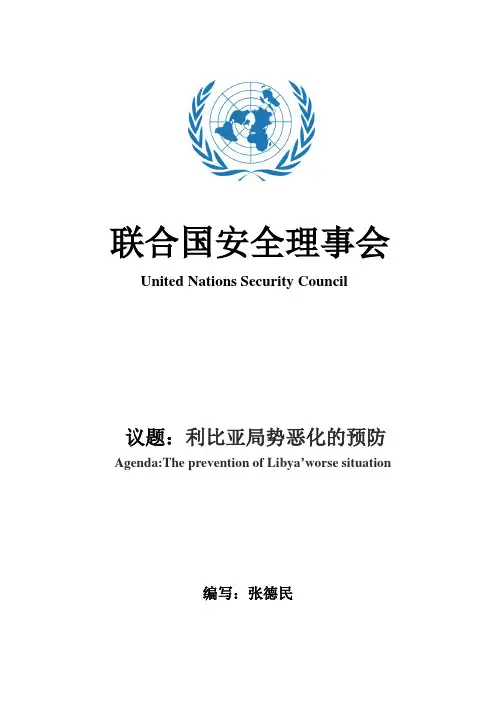
联合国安全理事会United Nations Security Council议题:利比亚局势恶化的预防Agenda:The prevention of Libya’worse situation编写:张德民目录一.背景简介二.委员会介绍三.已有的行动四.议题介绍五.需注意的问题六.国家立场七.给代表的几点建议八.结束语一.背景简介利比亚局势到了千钧一发之际。
有消息称,利政府军已攻入班加西城区;另一方面,法国总统萨科齐在3月19日召开的有关利比亚局势的巴黎峰会表示,如果卡扎菲不马上停火,将采取军事行动……就在英法等国磨刀霍霍之际,卡扎菲的军队向反对派大本营班加西发起了进攻。
就在此前不久,利比亚外长穆萨宣布全面停火。
外国军事干预已经开始,这给利比亚未来局势添了太多的不确定性。
首先,如果卡扎菲军队最终占领班加西,那么接下来交战双方是利政府军与反政府武装,还是利政府军直接面对外国军队?其次,即便反政府武装能够重整旗鼓,但在缺少外国军队地面支持的情况下,能否打败装备相对精良的政府军?第三,虽然英法空军打着保护平民的旗号进入利比亚领空,但是对利政府军采取军事行动的时候,能否保证不伤及无辜呢?最后,如果真出现了“后卡扎菲时代”,谁能保证这个部落势力极盛的国家不变得四分五裂?种种问题目前都没有答案,但有一点或许是肯定的,当法国军机进入利比亚领空的那一刻起,可怕的潘多拉魔盒已经打开。
二.委员会介绍联合国安全理事会United Nations Security Council (UNSC)是联合国六大主要机构之一,由中国、法国、俄罗斯、英国、美国等5个常任理事国和10个非常任理事国组成。
非常任理事国按地区分配原则由大会选举产生,任期两年,不能连选连任。
《宪章》规定,安理会在维护国际和平及安全方面负有主要责任,职能是:根据宪章规定作出全体会员国都有义务接受并执行的规定;调查任何国际争端或可能引起国际摩擦或争端的任何情况,断定威胁和平、破坏和平或侵略的行动,并采取经济、外交或军事制裁行动来反对侵略;负责拟订军备管制的计划;向大会推荐新会员国和秘书长。
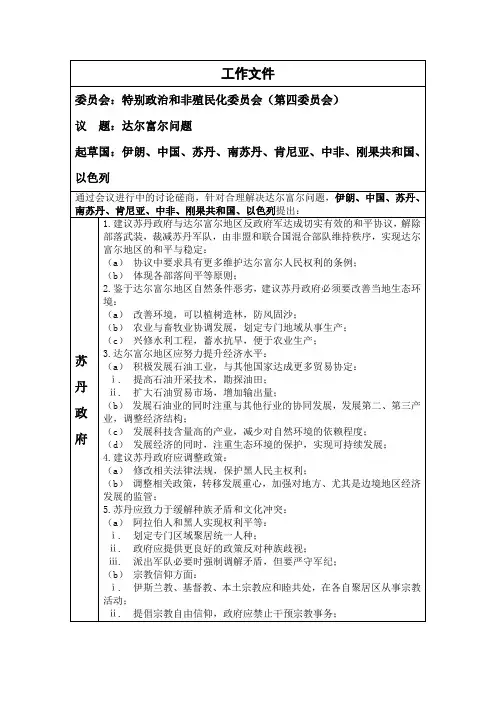
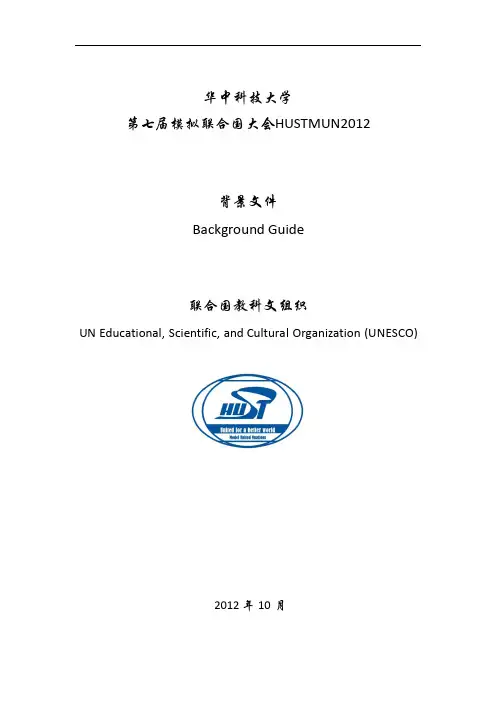
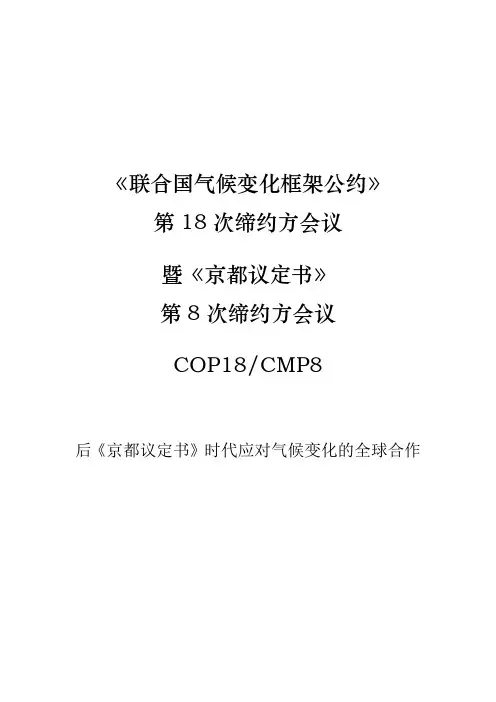
《联合国气候变化框架公约》第18次缔约方会议暨《京都议定书》第8次缔约方会议COP18/CMP8后《京都议定书》时代应对气候变化的全球合作目录主席团欢迎辞 (2)委员会介绍 (3)缔约方会议(COP)历程 (4)气候变化 (7)重要的文件 (10)焦点问题 (12)代表需要注意的问题 (12)对重点问题的解释 (12)各国立场 (14)希望之门——致第二届华工模联中文组代表们的欢迎辞亲爱的模联有缘人:展信佳!四月的广州,万象更新,生机焕发。
一切都似乎在期待着夏的欢腾。
而华工模联,也正踏着矫健的步伐,又一次向我们走来。
在2011年夏,华南理工大学举办了第一届模拟联合国大会。
经过公关协会的精心筹备以及资深模联人莫彦聪先生的悉心指导,第一届华工模联取得了巨大的成功。
第一届华工模联不仅让与会代表领略了模联的魅力,得到了个人的提升,也让模联的种子在华园生根发芽,茁壮成长。
华工的模联之路,迈出了坚实的第一步。
纵观全中国,模拟联合国的历史就是一段辉煌的乐章。
自上世纪末北京大学的引进,模联在中国的发展便如星火燎原之势,逐渐受到许多优秀大中学生的欢迎。
国内多所知名大学,如北大、复旦、南开等,都先后成立了模联组织,连续多年举办了许多水平高超,各具特色,知名度高的模联大会,其中包括由中国联合国协会(China United Nations Association)主办的中国模拟联合国大会、由外交学院主办的北京模拟联合国大会(Beijing Model United Nations)、由北京大学模拟联合国协会主办的亚洲国际模拟联合国大会(Asian International Model United Nations, Peking University)。
而在中学生之间,模联也逐渐展现出她的魅力。
特别是在珠三角,高中生参与模联的热情持续高涨。
在为精英提供展示卓越才华的机会的同时,模联也逐渐走向大众,为更多学生的成长提供了宝贵的机会。
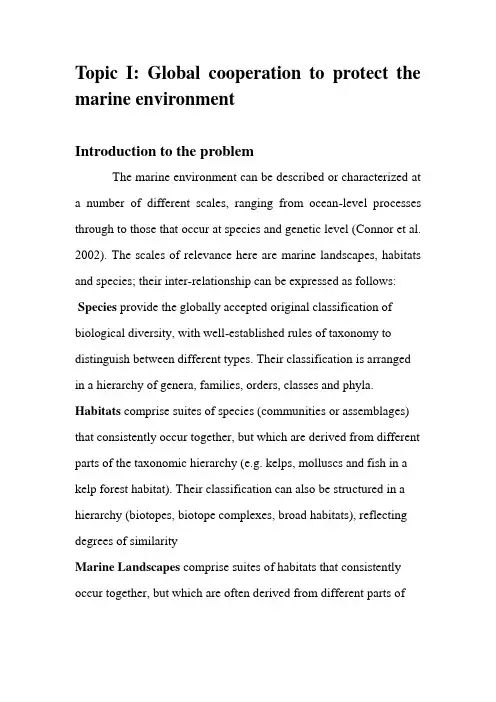
Topic I: Global cooperation to protect the marine environmentIntroduction to the problemThe marine environment can be described or characterized at a number of different scales, ranging from ocean-level processes through to those that occur at species and genetic level (Connor et al. 2002). The scales of relevance here are marine landscapes, habitats and species; their inter-relationship can be expressed as follows: Species provide the globally accepted original classification of biological diversity, with well-established rules of taxonomy to distinguish between different types. Their classification is arranged in a hierarchy of genera, families, orders, classes and phyla. Habitats comprise suites of species (communities or assemblages) that consistently occur together, but which are derived from different parts of the taxonomic hierarchy (e.g. kelps, molluscs and fish in a kelp forest habitat). Their classification can also be structured in a hierarchy (biotopes, biotope complexes, broad habitats), reflecting degrees of similarityMarine Landscapes comprise suites of habitats that consistently occur together, but which are often derived from different parts ofthe habitat classification hierarchy (e.g. salt-marsh intertidal mudflats, rocky shores and sub- tidal mussel beds in an estuary). Different types of pollutionPollution from shipsShips can pollute waterways and oceans in many ways. Oil spills can have devastating effects. While being toxic to marine life, polycyclic aromatic hydrocarbons (PAHS) found in crude oil, are very difficult to clean up, and last for years in the sediment and marine environment. Discharge of cargo residues from bulk carriers can pollute ports, waterways and oceans. In many instances vessels intentionally discharge illegal wastes despite foreign and domestic regulation prohibiting such actions. It has been estimatedthat container ships lose over 10,000containers at sea each year (usually during storms).Ships also create noise pollution that disturbs natural wildlife, and water from ballast tanks can spread harmful algae and other invasive species.Atmosphere pollutionGraph linking atmospheric dust to various coral deaths across the Caribbean Sea and FloridaAnother pathway of pollutionoccurs through the atmosphere. Wind blown dust and debris, including plastic bags, are blown seaward from landfills and other areas. Dust from the Sahara moving around the southern periphery of the subtropical ridge moves into the Caribbean and Florida during the warm season as the ridge builds and moves northward through the subtropical Atlantic.Dust can also be attributed to a global transport from the Gobi and Taklamakan deserts across Korea, Japan, and the Northern Pacificto the Hawaiian Islands. Since 1970, dust outbreaks have worsened due to periods of drought in Africa. There is a large variability in dust transport to the Caribbean and Florida from year to year; however, the flux is greater during positive phases of the North Atlantic Oscillation. The USGS links dust events to a decline in the health of coral reefs across the Caribbean and Florida, primarily since the 1970s.AcidificationIsland with fringing reef in the Maldives . Coral reefs are dying around the world.The oceans are normally a natural carbon sink, absorbing carbon dioxide from the atmosphere. Because the levels of atmospheric carbon dioxide are increasing, the oceans are becoming more acidic. The potential consequences of ocean acidification are not fully understood, but there are concerns that structures made of calcium carbonate may become vulnerable to dissolution, affecting corals and the ability of shellfish to form shells.Oceans and coastal ecosystems play an important role in the global carbon cycle and have removed about 25% of the carbon dioxide emitted by human activities between 2000 and 2007 and about half the anthropogenic CO2 released since the start of the industrial revolution. Rising ocean temperatures and ocean acidification means that the capacity of the ocean carbon sink will gradually get weaker, giving rise to global concerns expressed in the Monaco and Manado Declarations.Plastic debrisMarine debris is mainly discarded human rubbish which floats on, or is suspended in the ocean. Eighty percent of marine debris is plastic - a component that has been rapidly accumulating since the end of World War II. The mass of plastic in the oceans may be as high as one hundred million metric tons.Discarded plastic bags, six pack rings and other forms of plastic waste which finish up in the ocean present dangers to wildlife and fisheries .Aquatic life can be threatened through entanglement, suffocation, and ingestion. Fishing nets, usually made of plastic, can be left or lost in the ocean by fishermen. Known as ghost nets, these entangle fish, dolphins,seaturtles, sharks, dugongs, crocodiles, seabirds, crabs, and other creatures, restricting movement, causing starvation, laceration and infection, and, in those that need to return to the surface to breathe, suffocation.Remains of an albatrosscontaining ingested flotsamMany animals that live on or in the sea consume flotsam by mistake, as it often looks similar to their natural prey. Plastic debris, when bulky or tangled, is difficult to pass, and may become permanently lodged in the digestive tracts of these animals, blocking the passage of food and causing death through starvation or infection.Plastics accumulate because they don't biodegrade in the way many other substances do. They will photodegrade on exposure to the sun, but they do so properly only under dry conditions, and waterinhibits this process.[50] In marine environments, photo degraded plastic disintegrates into ever smaller pieces while remaining polymers, even down to the molecular level. When floating plastic particles photo degrade down to zooplankton sizes, jellyfish attempt to consume them, and in this way the plastic enters the ocean food chain. Many of these long-lasting pieces end up in the stomachs of marine birds and animals, including sea turtles, and black-footed albatross.Historical PerspectiveThe oceans had long been subject to the freedom of-the-seas doctrine - a principle put forth in the seventeenth century essentially limiting national rights and jurisdiction over the oceans to a narrow belt of sea surrounding a nation's coastline. The remainder of the seas was proclaimed to be free to all and belonging to none. While this situation prevailed into the twentieth century, by mid-century there was an impetus to extend national claims over offshore resources. There was growing concern over the toll taken on coastal fish stocks by long-distance fishing fleets and over the threat of pollution and wastes from transport ships and oil tankers carrying noxious cargoes that plied sea routes across the globe. The hazard of pollution was ever present, threatening coastal resorts and all forms of ocean life. The navies of the maritime powers were competing to maintain a presence across the globe on the surface waters and even under the sea.A tangle of claims, spreading pollution, competing demands for lucrative fish stocks in coastal waters and adjacent seas, growing tension between coastal nations' rights to these resources and those of distant-water fishermen, the prospects of a rich harvest of resources on the sea floor, the increased presence of maritime powers and the pressures of long-distance navigation and aseemingly outdated, if not inherently conflicting,freedom-of-the-seas doctrine - all these were threatening to transform the oceans into another arena for conflict and instability. In 1945, President Harry S Truman, responding in part to pressure from domestic oil interests, unilaterally extended United States jurisdiction over all natural resources on that nation's continental shelf - oil, gas, minerals, etc. This was the first major challenge to the freedom-of-the-seas doctrine. Other nations soon followed suit. In October 1946, Argentina claimed its shelf and the sea above it. Chile and Peru in 1947, Ecuador in 1950, asserted sovereign rights over a 200-mile zone, hoping thereby to limit the access of distant-water fishing fleets and to control the depletion of fish stocks in their adjacent seas.Soon after the Second World War, Egypt, Ethiopia, Saudi Arabia, Libya, Venezuela and some Eastern European countries laid claim to a 12-mile territorial sea, thus clearly departing from the traditional three-mile limit.Later, the archipelagic nation of Indonesia asserted the right to dominion over the water that separated its 13,000 islands. The Philippines did likewise. In 1970, Canada asserted the right toregulate navigation in an area extending for 100 miles from its shores in order to protect Arctic water against pollution.From oil to tin, diamonds to gravel, metals to fish, the resources of the sea are enormous. The reality of their exploitation grows day by day as technology opens new ways to tap those resources.In the late 1960s, oil exploration was moving further and further from land, deeper and deeper into the bedrock of continental margins. From a modest beginning in 1947 in the Gulf of Mexico, offshore oil production, still less than a million tons in 1954, had grown to close to 400 million tons. Oil drilling equipment was already going as far as 4,000 meters below the ocean surface.The oceans were being exploited as never before. Activities unknown barely two decades earlier were in full swing around the world. Tin had been mined in the shallow waters off Thailand and Indonesia. South Africa was about to tap the Namibian coast for diamonds. Potato-shaped nodules, found almost a century earlier and lying on the seabed some five kilometers below, were attracting increased interest because of their metal content.And then there was fishing. Large fishing vessels were roaming the oceans far from their native shores, capable of staying away from port for months at a time. Fish stocks began to show signs ofdepletion as fleet after fleet swept distant coastlines. Nations were flooding the richest fishing waters with their fishing fleets virtually unrestrained: coastal States setting limits and fishing States contesting them. The so-called "Cod War" between Iceland and the United Kingdom had brought about the spectacle of British Navy ships dispatched to rescue a fishing vessel seized by Iceland for violating its fishing rules.Offshore oil was the centre of attraction in the North Sea. Britain, Denmark and Germany were in conflict as to how to carve up the continental shelf, with its rich oil resources.It was late 1967 and the quietness of the sea was slowly being disrupted by technological breakthroughs, accelerating and multiplying uses, and a super-Power rivalry that stood poised to enter man's last preserve - the seabed.It was a time that held dangers and promises, risks and hopes. The dangers were numerous: nuclear submarines charting deep waters never before explored; designs for antiballistic missile systems to be placed on the seabed; supertankers ferrying oil from the Middle East to European and other ports, passing through congested straits and leaving behind a trail of oil spills; and rising tensions between nations over conflicting claims to ocean space and resources.The oceans were generating a multitude of claims, counterclaims and sovereignty disputes.The hope was for a more stable order, promoting greater use and better management of ocean resources and generating harmony and goodwill among States that would no longer have to eye each other suspiciously over conflicting claims.On 1 November 1967, Malta's Ambassador to the United Nations asked the nations of the world to look around them and open their eyes to a looming conflict that could devastate the oceans, the lifeline of man's very survival. In a speech to the United Nations General Assembly, he spoke of the super-Power rivalry that was spreading to the oceans, of the pollution that was poisoning the seas, of the conflicting legal claims and their implications for a stable order and of the rich potential that lay on the seabed.Significant documents―Marine and coast sustainable development blueprintThe United Nations convention on the international oceanAthens protocolAgenda 21: put forward in United Nations Conference on 1992-Environment and Development (UNCED) held in Rio deJaneiro, BrazilThe northeast Atlantic oceans environmental protection conventions 1954- International convention of preventing oil pollution of the sea 1972-convention of preventing dumping waste or other matter pollution of the seaCurrent situation and global challenges: Enormous disparities currently exist between the actions taken by different countries. The preservation of marine arouses global awareness and calls for international cooperation.Some countries have turned their thoughts into actions, taking the lead in the protection of marine. Take Australian government for instance, the Australian Maritime Safety Authority (AMSA) manages the National Plan, working with State/Northern Territory (NT) governments, the shipping, oil, exploration and chemical industries, emergency services to maximize Australia’s marine pollution response capability. The National Plan Management Committee (NPMC) provides strategic management of the National Plan while the National Plan Operations Group (NPOG) handles operational functions.The measurements have been accepted universally, and triggered wider emphasis throughout the globe, especially during this very occasion, where the marine is under the onslaught ofnumerous technical innovations. As for some countries which abut oceans, they tend to utilize the marine resources in every way that the resources can be utilized. Being confronted with brand new fishing methods, many countries choose to pollute rather than protect. Ship sourced pollution seems to be increasingly serious that calls for worldwide actions. Another action taken up by Australia is that all the individuals are entitled to report the incident to AMSA or the local marine authority if had witnessed a vessel polluting. The polluting actions shall include, first, any quantity of oil, waste oil, fuel oil, sludge, lube oil, etc; second, any discharge from a ship involving washings of chemical or dry cargoes; third, any plastic material and garbage disposed of in the sea within 12nm of land.It seems like not a single country can really deny the fact that the pervasive and influential technologies has already been used in marine exploitation, and of course, the certain countries are enjoying the benefits that have been brought with. With such merits and edges, technology speaks for itself. It is not the technology itself to blame for, but the awareness that worthy rational consideration. There are several countries have been taking steps towards marine conservation.Past International actionsUnder the international cooperation proposed by UN, marineprotection has been placed on a higher level.European Union has adopted an instrument, Marine Strategy Framework Directive, in 2008, which offers a comprehensive and integrated approach to the protection of all European marine waters.The Directive involves many implementation challenges, which are addressed through a Common Implementation Strategy between the Commission and the Member States and a regional approach to the implementation of its objectives.Marine conservation is a long-run project and serves forlong-term benefit of general interest, therefore, the certain project shall be given priority to.Proposed solutionIn 2009, UNEP in collaboration with the Government of Kenya produced the publication Kenya: Atlas of Our Changing Environment which revealed the grave extent of the forest’s depletion – over 25 percent of forest cover has been lost over the past two decades to ecosystem encroachments like unplanned settlements and illegal logging. Based on these findings, a ten-point plan was prepared by the Mau Forest Task Force together with other major stakeholders. UNEP and the Government of Kenya are now working to restore this vital ecosystem.The United Nations Conference on Environment and Development was held in Rio de Janeiro, Brazil, in June 1992. This conference,which has also come to be known as the ―Earth Summit,‖ marked the beginning of a new round of world conferences focusing on the analysis of development problems. This ―new social cycle‖ of United Nations conferences was launched in response to the wishes of Member States and has led to a renewal of efforts first made 20 years ago to find solutions to the most pressing problems coming to the fore on the global stage. These conferences have also contributed to the ethical and political consolidation of a cooperation regime based on new international legal principles.The Conference in Rio de Janeiro laid the groundwork for a new world consensus on sustainable development and on global conventions dealing with emerging issues such as biological diversity and climate change.1 This led to the creation of institutions and to the formulation of government strategies and policies for the promotion of sustainable development. It also prompted steps to address this issue within the spheres of education, culture and the media.Bloc positionWestern Asian Note: Western Asia Region includes the following 13 countries only: Bahrain, Egypt, Iraq Jordan, Kuwait, Lebanon, Oman, Palestine, Qatar, Saudi Arabia, Syrian Arab republic, United ArabEmirates and Yemen.The present report portrays the wide gap currently separating between the requirements of sustainability and the reality of economic development politics in the Western Asia Region. Despite the facts that SD has become one of the basic commitments of the Western Asia Region since Rio1992, much more remains to be done to transform the principle into daily practice. The report is a stock-taking, almost nine year after Rio, of what has been attempted and achieved in the Western Asia Region by national governments, regional and sub-regional bodies to implement the concepts of Sustainable Development (SD). The report also sets out the major issues that the roundtable believes prevent the attainment of coherent and strong SD policies in the Western Asia Region. On the positive side, National & local agenda-21 (LA-21), National Sustainable Development Strategies (NSDS), cross-sector National Environmental Strategies (NES) and National Environmental Action Plans (NEAP) have been formulated in most of the Western Asia Region providing blueprints for action and setting time-bound goals and targets.Since UNCED, 1992 there has also been a fast growing participation by the major groups through NGOs, civil societies, trade unions, and private sectors in the environmental decision-making process in the region. On the institutional level, some countries of the Western Asia Region have made substantial progress in setting up for SD. Furthermore,national councils or coordinating bodies in the field of SD and NGOs are flourishing in some countries of the Western Asia Region.A major positive development was the declaration of the Council of Arab Ministers Responsible for Environment (CAMRE) in their meeting in Abu-Dhabi, UAE on 3r d of February 2001, that there is an urgent need for alleviation of poverty and improvement of living standards and economic conditions of the Arab citizen through programs of SD. This declaration including its associated commitments was later adopted at the Arab summit meeting in March 2001 in Amman giving the declaration the legitimacy and momentum for implementation at the regional level. Unfortunately, the roundtable discussions revealed that most of the countries of the Western Asia Region are faced with inadequate technical, human and financial resources. The regional situation is further complicated by unfavorable international atmosphere. The main challenge facing most decision-makers in the Western Asia Region is how to effectively integrate multi- sector SD policies in a consolidated strategy. Despite all their efforts to avoid the prevailing piece-meal approach, governments in the Western Asia Region are still away from achieving inter-linkages, interdependencies, synergy and coherence in their policy initiatives and policies. The roundtable was able to identify and sum-up four major obstacles, which impede the achievement of SD in the Western Asia Region, these are: 1.Inadequate freshwater supplies andpoor land resources. 2. Lack of peace and security in the region. 3. Inadequate monitoring and access to credible information. 4. Inadequate public participation in decision-making led to ineffective governance for SD. Freshwater supply in the Western Asia Region was found to be highly variable in time and space. The collection of hydrological, meteorological, ecological and socio-economic information for water resources management is still severely hindered at the field level by inadequate resources and financial constraints. Most countries of the region have developed water policies to manage water scarcity by devising programs based mostly on resources development and to a much lower extent on demand management. The situation at the regional level is also aggravated by the social and cultural impact of globalization on societies including uneven distribution of the benefits of development, rapid pace of technological change and the information revolution. This resulted into faster socio-economic growth, created new opportunities and consequently yielded higher living standards in most of the developed world. However, these benefits were unevenly distributed and the Western Asia Region was almost marginalized. The imbalance between the fast expanding global markets and the inadequate access to the market by countries of the Western Asia Region has hindered their beneficial integration in the world economy. There is a general feeling of suspicion among countries of the Western Asia Region that it is a dubious conceptthat will signify increase social economic and ecological 4 vulnerability. Some efforts are underway to formulate an Arabic Economic Alliance. The impact of these efforts remains to be seen. In face of prevailing unemployment, poverty and weak infrastructures in some countries of the Western Asia Region, the roundtable expressed deep concern that there is a danger that SD could take a backseat and its priority reduced as the social & political pressures for accelerated economic development overwhelm governments. On the positive side, the age structure is in favor of all countries of the Western Asia Region where youth represent a relatively high percent of the societies. At the regional level, the Western Asia Region has to assess their degree of success and/or failure in reconciling their economic and environmental agendas. Countries of the Western Asia Region should co-operatively be able to define the characteristics of modern SD governance tools & trends that reflect the practical lessons learned from our shared past experience. These should definitely include the need to carefully set priorities, pursue cost-effective solutions and seek synergy in policy reforms that result in environmental improvements while promoting socio -economic development. AfricanOn the basis of the UNEP GC decisions on support to Africa and NEPAD, UNEP and a number of UN agencies, continue to work together within the Regional Coordination Mechanism (RCM), a mechanism forcoordinated UN support to the African Union (AU) and its NEPAD program, under the overall coordination of the UN Economic Commission for Africa (ECA). UNEP is the governor of the cluster on Environment, Population and Urbanization of the Regional Coordination Mechanism (RCM). Through its Addis Ababa office, UNEP has a strategic role and presence which facilities closer cooperation in furtherance of the African Union Commission (AUC) programs, including NEPAD. The UNEP Addis Ababa office also takes part in the UN partnerships aimed at extending support to the implementation of the actions recommended by the regional coordination mechanism particularly with respect to the UN clusters of support to NEPAD. In addition, UNEP as the secretariat of the African Ministerial Conference on the Environment (AMCEN) continues to support the implementation of the decisions of AMCEN and its work program, which is an integral part of the action plan for the environment initiative of NEPAD. It will be recalled that AMCEN led the process for the development of the action plan for the environment initiative of NEPAD. Financial supports for NEPAD programs and projects. During the period from July 2010 to April 2011, UNEP continued to extend support to NEPAD through the provision and mobilization of financial resources for the implementation of a number of activities. The specific areas of support include the following: Program Area 1: Combating land degradation, drought anddesertification It will be recalled that recognizing the pervasiveness and severity of land degradation and its impact on livelihoods and on the economies of sub-Saharan African countries, and to complement the Global Environment Facility country partnership program targeting that problem, the World Bank initiated the Terror Africa program. Terror Africa is a global partnership designed as a multi-partner platform organized around three programmatic outcomes, with a view to enabling African Governments and their partners to scale up the mainstreaming and financing of effective and efficient country-driven sustainable land management approaches. It serves to focus attention, facilitate sharing of knowledge and best practices, galvanize advocacy and make the case for increased investment in support of sustainable land management interventions. In Kenya, UNEP has, during the period in consideration, been supporting the country to restore the Mau Forest Complex, which is the anchor of Kenya’s natural resources. In 2009, UNEP in collaboration with the Government of Kenya produced the publication Kenya: Atlas of Our Changing Environment which revealed the grave extent of the forest’s depletion – over 25 percent of forest cover has been lost over the past two decades to ecosystem encroachments like unplanned settlements and illegal logging. Based on these findings, a ten-point plan was prepared by the Mau Forest Task Force together with other major stakeholders. UNEP and the Government of Kenya are now working torestore this vital ecosystem. Programmatic Area 4: Conservation and sustainable use of marine, coastal and freshwater resources The implementation of the marine, coastal and freshwater resources component of the action plan for the environment initiative of NEPAD continues to be implemented through the Abidjan Convention for Protection, Management and Development of the Marine and Coastal Environment of the West and Central African region (Abidjan Convention) and the Nairobi Convention for Protection, Management and Development of the Marine and Coastal Environment of the Eastern African Region (Nairobi Convention).Latin AmericaLatin America and the Caribbean, only Barbados, Haiti and Peru suffer from water stress,6 although there are various areas of other countries which are in this situation (northeast and northwest Mexico, areas of the Pacific coast of Central and South America, some areas of the Andean Plateau and extensive areas of Patagonia). Whereas in other regions of the world the population clearly perceive water shortage to be the main limitation on their development processes and have generated a special culture in this respect, in LatinAmerica and the Caribbean there is only an incipient awareness of the need for rational management of water resources because of。
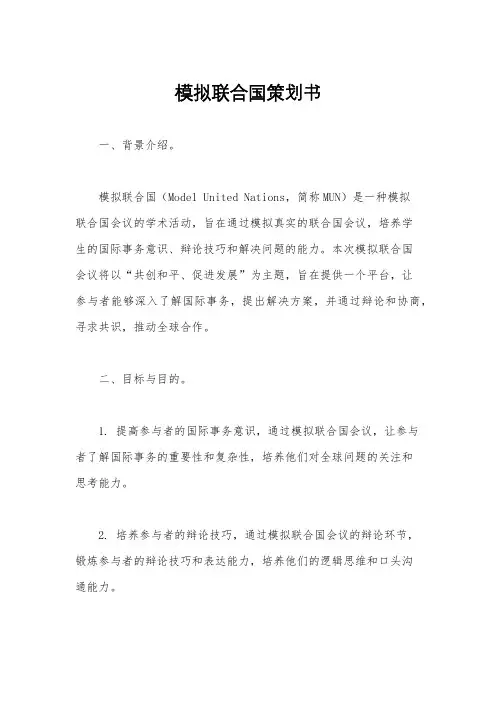
模拟联合国策划书一、背景介绍。
模拟联合国(Model United Nations,简称MUN)是一种模拟联合国会议的学术活动,旨在通过模拟真实的联合国会议,培养学生的国际事务意识、辩论技巧和解决问题的能力。
本次模拟联合国会议将以“共创和平、促进发展”为主题,旨在提供一个平台,让参与者能够深入了解国际事务,提出解决方案,并通过辩论和协商,寻求共识,推动全球合作。
二、目标与目的。
1. 提高参与者的国际事务意识,通过模拟联合国会议,让参与者了解国际事务的重要性和复杂性,培养他们对全球问题的关注和思考能力。
2. 培养参与者的辩论技巧,通过模拟联合国会议的辩论环节,锻炼参与者的辩论技巧和表达能力,培养他们的逻辑思维和口头沟通能力。
3. 提升参与者的问题解决能力,通过模拟联合国会议的协商和合作过程,培养参与者的问题解决能力和团队合作精神,让他们学会通过协商和合作达成共识。
三、活动内容。
1. 模拟联合国会议,参与者将分为不同的国家代表团,模拟联合国会议的各个委员会,讨论和解决各种国际问题。
会议将模拟真实的联合国会议流程,包括发言、辩论、提案和投票等环节。
2. 主题演讲,邀请专家学者就全球问题进行主题演讲,为参与者提供背景知识和启发思考。
3. 辩论训练,组织辩论训练活动,提供辩论技巧的指导和实践机会,帮助参与者提升辩论能力。
4. 团队合作项目,组织参与者参与团队合作项目,培养他们的团队合作精神和问题解决能力。
5. 文化交流活动,安排文化交流活动,让参与者了解不同国家和文化,促进跨文化交流与理解。
四、预期效果。
1. 提高参与者的国际事务意识和全球视野,培养他们成为有责任感和使命感的全球公民。
2. 培养参与者的辩论技巧和表达能力,提升他们的口头沟通和逻辑思维能力。
3. 培养参与者的问题解决能力和团队合作精神,让他们学会通过协商和合作解决问题。
4. 促进跨文化交流与理解,培养参与者的国际交往能力和文化包容性。
五、组织与实施。
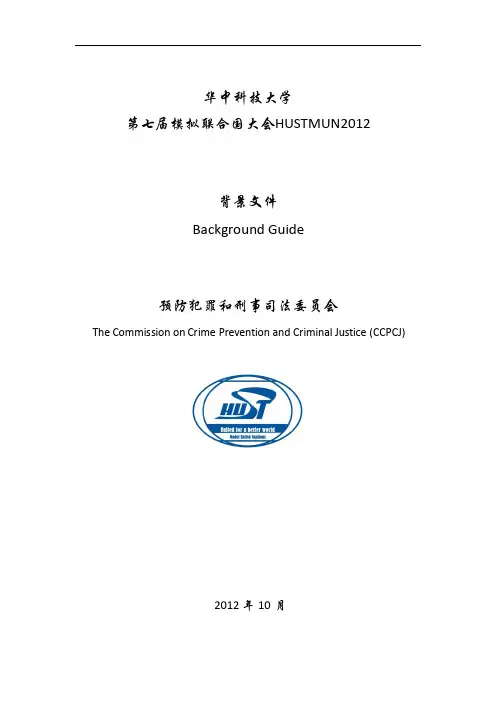
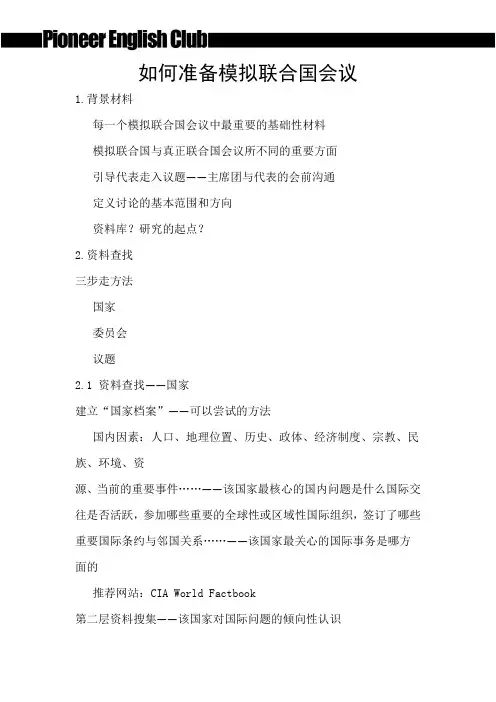
如何准备模拟联合国会议1.背景材料每一个模拟联合国会议中最重要的基础性材料模拟联合国与真正联合国会议所不同的重要方面引导代表走入议题——主席团与代表的会前沟通定义讨论的基本范围和方向资料库?研究的起点?2.资料查找三步走方法国家委员会议题2.1 资料查找——国家建立“国家档案”——可以尝试的方法国内因素:人口、地理位置、历史、政体、经济制度、宗教、民族、环境、资源、当前的重要事件……——该国家最核心的国内问题是什么国际交往是否活跃,参加哪些重要的全球性或区域性国际组织,签订了哪些重要国际条约与邻国关系……——该国家最关心的国际事务是哪方面的推荐网站:CIA World Factbook第二层资料搜集——该国家对国际问题的倾向性认识帮助寻找到相近立场的国家集团——找朋友可以着重考察的方面:*军备与安全问题*人权问题*环境与可持续发展问题……2.2 资料查找——委员会(1)更有针对性的任务设立目的、成立时间背景、成员有哪些、职能是什么、机构设置——委员会的官方网站是每个researcher 的首要选择(2)更深一步地了解:该委员会运行情况如何?是否是个务实的机构?各方对该委员会职能实现程度如何评价?各个国家多大程度上体现平等?……2.3 资料查找——议题最重要的一环*议题的由来和历史*议题可讨论的有哪些方面*可以关注的点:联合国宪章、已有的条约决议、秘书长的发言……*是否是自己国家关心的问题。
该国领导人的发言、国内立法……3.立场文件• 格式要求,时间要求• 表明国家基本立场观点• 会议期间提醒代表自己国家的基本底线• 综合搜集到的资料完成• Tips: 看看背景材料里提的问题能回答多少• 不要空洞,说明该国家认为解决的方案是什么。
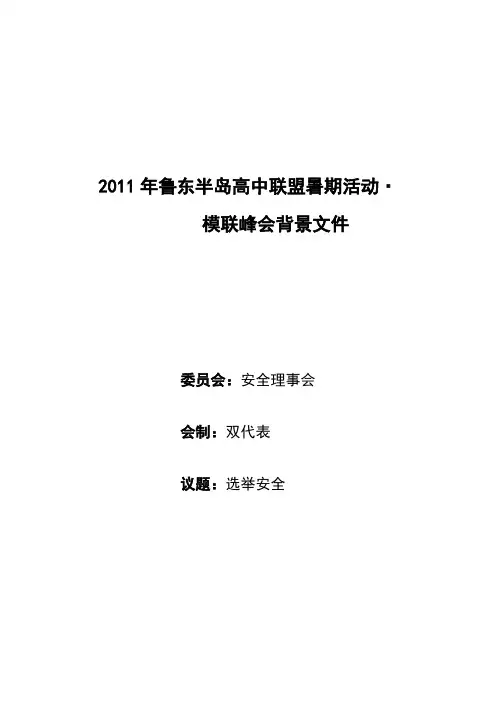
2011年鲁东半岛高中联盟暑期活动·模联峰会背景文件委员会:安全理事会会制:双代表议题:选举安全目录一、委员会介绍——————————————————-3二、议题介绍——————————————————— 91、问题阐述————————————————————————————92、历史背景————————————————————————————123、问题现状————————————————————————————144、安理会角色———————————————————————————155、联合国相关行动—————————————————————————166、解决方案————————————————————————————177、亟须解决的问题—————————————————————————188、集团立场————————————————————————————18三、对各位代表的建议————————————————20一、委员会介绍1、概况中文:联合国安全理事会英文:United Nations Security Council (UNSC)2、性质联合国安全理事会(简称安理会)是联合国的6大主要机构之一。
根据联合国宪章的宗旨及原则,安理会负有维持国际和平与安全的责任,是唯一有权采取行动的联合国机构3、职权安理会有权调查任何引起国际争端或摩擦的任何情况,并可提出解决这些争端的方式或办法。
会员国或接受联合国宪章的非会员国、联合国大会或秘书长,均可就国际和平与安全问题提请安理会注意。
安理会有权断定任何威胁和平、破坏和平或侵略等行为的存在,并可提出采取强制措施以维持或恢复国际和平与安全的建议或作出这方面的决定,如认为这些措施还不能解决问题,它可以通过采取关于军事行动的决议去解决这些问题。
安理会还有向联合国大会提出年度报告、特别报告、对战略性地区行使托管等职能。
在其他方面,安理会与大会分别选举国际法院法官,建议或决定应采取的措施以执行国际法院的判决,向大会推荐新会员国和联合国秘书长,向大会建议停止会员国的权利或开除会员国,参加宪章规定的修正程序。
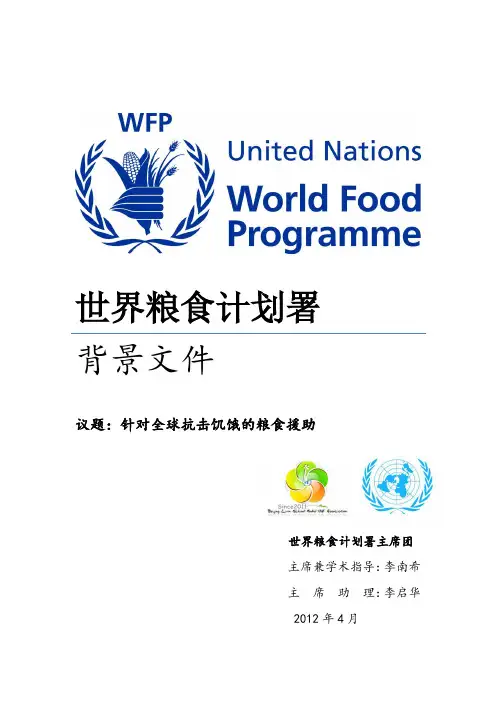
Guangdong Experimental High SchoolModel United Nations SocietySaga SquadProudly presents:SAGA MUN Conference English Committee: Elimination of Child LaborInternational Labor OrganizationBackground Guide[Update One]Inside:A.Introduction of TopicB.Role-play settingsC.Case StudyPart A.Introduction of topica.Our CommitteeThe International Labor Organization(ILO)is devoted to advancing opportunities for women and men to obtain decent and productive work in conditions of freedom,equity, security and human dignity.Its main aims are to promote rights at work,encourage decent employment opportunities,enhance social protection and strengthen dialogue in handling work-related issues.The ILO is the only'tripartite'United Nations agency in that it brings together representatives of governments,employers and workers to jointly shape policies and programs.This unique arrangement gives the ILO an edge in incorporating'real world' knowledge about employment and work.The ILO is the global body responsible for drawing up and overseeing international labor standards.Working with its Member States,the ILO seeks to ensure that labor standards are respected in practice as well as principle.b.Our TopicOur topic this time will be the elimination of Child Labor.In the world nowadays,an estimated120million young people between the ages of5and 14work full-time,and a further130million work part-time.Poverty,within the family or community,is the main reason why children have to go out to work.Many of them work in factories,workshops or other hazardous environments,such as mines,which can be dangerous or damaging to their health.Many more,especially girls,are domestic workers. Child workers are very vulnerable to exploitation and long working days often disrupt their education.Work is a fact of life for millions of children,especially in South Asia and Africa. For many families,income from the work of the children makes the difference between survival and destitution.c.Our Mission“As long as there is poverty in the world I can never be rich,even if I have a million dollars.I can never be what I ought to be until you are what you ought to be.be.””Martin Luther King----------Martin This time our committee will explore some of the reasons why child labor happens, highlighting poverty as the major factor.We will also explore why children don’t always get a choice and examines how the ILO together with the world can works with local people and change things for the better.Part B.Role Play SettingsAsian Countries:BengalThe PhilippinesIndonesiaIndiaThe People’s Republic of ChinaKazakhstan American Countries :United States of AmericaBrazilPeruChile NGO and Others:Representative of UNICEFHead of International Abolition of Child Labor Program,Frank HagmanCorporation Representatives:Wal-MartMarlboroMicrosoft &Dongguan Kunying CompanyAfrican Minerals CorporationAfrican Countries:Ethiopia Sierra-Leone Uganda Kenya RwandaEuropean Countries:The United Kingdom Russian Federation France GermanyPart C.Case studya.Rekha–bangle-makingRekha is nine years old and works with other children at her aunt’s house at Ferozabad making glass bangles.To make the bangles she melts the glass and adds color to make them attractive.The work is dangerous because the fumes cause discomfort to the eyes.“I like working because I get money but sometimes my hands hurt,and I don’t like the smell.And if I sit for a long time I feel achy.I give the money to my mother.I work because my mother tells me to,and so that I can go to school to learn.It’s good to learn,because if I learn I won’t have problems.”Save the Children,withpartner organizations,has helped to set up aco-operative,so that families can dispense withthe middleman,allowing families to makemore money by reducing their poverty levels.The children will also be able to work less.b.Adane–tending livestockTen-year-old Adane works as a shepherd,looking after livestock in Ethiopia.His job isunpaid,but he receives food from his employer.“There are ten people in my family.My father died when I was a baby.We have some land for crops,but it gets dry from the sun;and when the rain is heavy it washes the seeds away.I go to school from September to June,andI work in the‘kremt’[rainy season].But sometimes I miss out on school because I have to work.Sometimes we have no food at all.If there’s no food at home and I go to school,I can’t understand what the teacher says because it is difficult to concentrate.”c.Keys for approaching this issue1.Poverty2.Gender discrimination,3.Family tracing and reunification programs4.The most hazardous and exploitative forms of children’s work5.Good partnerships between children,communities and people6.Children’s working conditions and their rights for appropriate education,Healthcare andrecreation.。
Global Classrooms ®: BeijingHosted by Peking University 北京大学主办 Supported by UNA-USA 美国联合国协会支持 Sponsored by Merrill Lynch 美林集团赞助UNESCAP 主席团组成郑晶晶 北京大学经济学院05级本科 徐逸 北京大学国际关系学院06级本科 王汀滢 北京大学法学院06级本科 谢茵 北京大学法学院07级本科 高雪 北京大学元培计划实验班07级本科(以上为本章节编写人员)目录 (225)主席欢迎辞 (226)委员会介绍 (227)议题一:应对油价高企,维护地区经济快速增长 (151)议题介绍 (228)议题的提出 (152)第一部分:面临的问题 (138)第二部分:详细介绍 (230)过去采取的行动 (237)当前的情况 (238)国家集团的立场 (240)思考与展望 (241)第一部分:其他重要问题 (241)第二部分:可能遇到的阻碍 (242)对代表的建议 (243)议题二:保护海洋资源,防治石油污染 (246)议题介绍 (246)议题的提出 (246)过去采取的行动 (252)当前情况 (254)思考与展望 (255)第一部分:其他重要问题 (255)第二部分:可能遇到的阻碍 (256)对代表的建议 (256)参考资料 (258)亲爱的代表们:欢迎你们来到亚洲及太平洋经济社会委员会,她将是本届模拟联合国大会中最有活力、最吸引人的委员会之一!作为联合国在亚太区域唯一的政府间综合性经济社会组织,亚洲及太平洋经济社会委员会以加强区域内国家和地区在经济和教育、科学、医疗、环境等社会各方面发展为宗旨,是政府间加强联系、交流经验、区域合作的重要渠道。
各位代表,在这个委员会中,我们将共同讨论我们所关心的经济社会问题。
随着高油价时期的来临,亚太经济受到明显影响。
同时,现代生产生活造成了不可忽视的海洋污染,给沿岸乃至全球的经济社会带来严重影响。
TYMUNC2010 2010年太原市模拟联合国大会United Nations Security Council 联合国安理会Backgroud Guide背景文件致代表的一封信各位亲爱的代表:你们好!欢迎你们参加 2010年太原市中学生模拟联合国大会!我是山西省实验中学的武文浩,很荣幸作为此次会议的联合国安全理事会的主席。
在此次会议中,我将主要负责会议辩论主持工作,希望大家能积极参加此次会议。
幸运的你们选择了联合国安全理事会这一重要委员会,请详细阅读下面的文件,充分发挥你们的才干,做一名合格的外交官!下面我来介绍我我与模拟联合国的相识相知。
起初,我参加模拟联合国的目的是锻炼自己的交往组织能力,渐渐地,我认识了一群跟我有着相同爱好的有志青年,在互相学习和交流中,我获得了长久的进步。
对于模拟联合国,我深深热爱并乐此不疲,希望通过此次会议,你也能真正领会到模拟联合国的魅力,热爱这项活动。
我曾经作为代表参加过蔚蓝2009会议wemun2009和人民大学青年领袖气候峰会GCCYC2009。
作为主席,我曾主持过校内模拟会议。
所以说,模联成为我高中最美好回忆之一。
我相信,这次会议将成为一次高水平会议,因此我十分期待。
希望你们能认真准备,在模拟联合国会议上书写出自己的辉煌!期待着七月份的欢聚!真诚的,武文浩山西省实验中学wwh7060226@联合国安理会简介一、性质及职权:联合国安全理事会(简称安理会)是联合国的6大主要机构之一。
根据联合国宪章的宗旨及原则,安理会负有维持国际和平与安全的责任,是唯一有权采取行动的联合国机构。
安理会有权调查任何引起国际争端或摩擦的任何情况,并可提出解决这些争端的方式或办法。
会员国或接受联合国宪章的非会员国、联合国大会或秘书长,均可就国际和平与安全问题提请安理会注意。
安理会有权断定任何威胁和平、破坏和平或侵略等行为的存在,并可提出采取强制措施以维持或恢复国际和平与安全的建议或做出这方面的决定,如认为这些措施还不能解决问题,它可以通过采取关于军事行动的决议去解决这些问题。
目录欢迎辞 (1)委员会介绍.................................议题概述 (3)巴以问题的历史背景 (4)一、早期巴勒斯坦地区历史概述 (4)二、犹太复国主义的出现 (5)三、英国委任统治下的巴勒斯坦 (5)四、联合国巴以问题分治决议 (6)五、阿以之间历次战争 (7)六、阿以早期和平进程 (12)七、国际社会关于整体解决阿以问题的方案 (15)八、中东全面和平进程 (17)新世纪以来巴以问题的继续发展 (19)一、沙龙当权及和平进程的全面停滞 (19)二、四方会谈和中东和平路线图计划 (19)三、沙龙的单边撤离计划 (20)四、“哈马斯”走上政治舞台 (21)解决巴以问题的新契机 (21)一、美国战略中心的转移和中东政策的转变 (21)二、哈马斯和法塔赫的和解 (22)三、国际社会的影响不断加强 (23)曾采取的措施 (23)部分国家的观点和立场 (26)一、主要国家与实体 (26)二、中东地区国家立场 (28)巴以焦点问题 (29)一、巴以边界划分问题 (29)二、耶路撒冷归属问题 (31)三、犹太人定居点问题 (33)四、巴勒斯坦难民回归问题 (35)五、水资源分配问题 (37)六、隔离墙问题 (40)思考与展望.......................................................................................................................................41参考文献 (42)欢迎辞尊敬的各位代表:大家好!欢迎大家参与到第三届北方民族大学模拟联合国大会安全理事会的会议中!作为主席团的成员,我们将竭尽所能,为大家奉献一次学术的完美的会议。
在遥远的西亚,有这么两个民族,他们从古至今从未停止过冲突;在约旦河西岸,有这样一座城市,作为圣城它早已不复原本的安静与祥和。
2014中山大学珠海校区翻译学院模拟联合国背景文件委员会:联合国粮食及农业组织议题:全球合作应对世界粮食危机目录一.致代表的一封信 (3)二.委员会介绍1.背景介绍 (4)2.组织机构 (5)3.职能和权力 (7)三.议题正文1.议题概述 (7)2.关于世界粮食危机…………………………………………………………………(1)主要表现 (8)(2)主要成因 (9)(3)粮食危机发展的历程和现状 (9)(4)国际社会采取的措施 (10)四.国家立场 (12)五.值得思考的问题 (12)六.资料来源 (12)一.致代表的一封信尊敬的各位代表:欢迎参加中山大学珠海校区2014年模拟联合国大会!模拟联合国(Model United Nations)是模仿当今联合国或其分支机构,依据其运作方式和议事原则围绕国际上的某一热点问题召开的会议。
青年学生们扮演各个国家的外交官,以联合国大会的形式,通过阐述观点、政策辩论、投票表决、做出决议等亲身经历,熟悉联合国的运作方式,了解世界发生大事对他们未来的影响。
这是世界政治、安全、经济等各种利益交织和博弈的缩影,也是你作为一名外交官展示才华、维护和平、探讨合作的舞台。
中珠模联正一步步探索着自己独特的发展道路。
本次模联以联合国千年发展目标的实现为背景,将目光聚焦在牵动全世界神经的粮食问题上,特别选取了“全球合作应对世界粮食危机”作为中文组的议题。
随着世界生产力的迅速发展,人类的温饱问题看似得到了很好的解决,但事实上,在许多发展中国家,仍然有千千万万人民为尚未达到温饱水平。
世界粮食安全因国家实力差异,大国的贸易垄断等诸多因素而蒙上阴影,为世界生产绝大多数粮食的发展中国家经常面临粮食危机,而发达国家却以占世界少数的人口消耗着世界绝大多数的粮食,世界粮食危机的爆发根源就在于粮食在世界范围内的分配不均。
中国、印度等发展中大国将努力为本国和第三世界在粮食问题上争取更多正当利益以缓解危机,而以美国、法国、英国为首的发达国家集团为保证国内经济持续稳定发展,也将极力巩固自身在国际粮食分配及贸易机制上的主导地位。
大连市第二十四中学中学生模拟联合国会议24MUNC 2014背景文件Background GuideUnion of European Football Associations Executive Committee欧洲足球协会联盟执行委员会Topic: EURO 2020 BidWelcome Letter from the ChairDear delegates,It’s my great honour to welcome you all to 24MUNC 2014, and more significantly, to the Union of European Football Association (UEFA). Our dais team and stuff are all very excited to meet you in just a few weeks.For those who don’t focus very much on football, don’t worry. This department is not only about football. It requires more understanding of the history and culture of a country, than the knowledge of football. To successfully bid the European Cup, the delegates need a lot of work, not about football, but about the economic background, cultural background, political background, environmental background, etc. For an extreme example, if a convincing and executive program is carried out, the Euro Cup can even be held in Iceland. So the UEFA is not a department of entertainment. A comprehensive task is upon you. The dais hope that you can finish it perfectly in one day’s time.If you have any questions about this committee or the conference, please do not hesitate to contact us. In the meantime, we urge you to use this topic guide as a stepping-stone for further research. Please read carefully all sections relating to the procedure and operation of this committee. We wish you the best of luck with youre research and hope you are excited for what promises to be the best committee at 24MUNC 2014!Sincerely yours,Chair at UEFA: Shengjun Zhai.Email: mystery-castle@Dais Member: Weimeng JinEmail:Dais Member: Siqing SunEmail:Introduction of the CommitteeThe Union of European Football Associations (French: Union des associations européennes de football), also referred to by its acronym UEFA is the administrative body for association football in Europe and, partially, Asia. It is one of six continental confederations of world football's governing body FIFA. UEFA consists of 54 national associations members.UEFA represents the national football associations of Europe, runs nation and club competitions including the UEFA European Championship, UEFA Champions League, UEFA Europa League, and UEFA Super Cup, and controls the prize money, regulations and media rights to those competitions.UEFA was founded on 15 June 1954 in Basel after consultation between the Italian, French, and Belgian associations. Initially, the European football union consisted of 25 members which number doubled by the early 1990s. UEFA membership coincides for the most part with recognition as a sovereign country in Europe, although there some exceptions. Some micro states, (e.g. the Vatican City) are not members. Some UEFA members are not sovereign states, but form part of a larger recognised sovereign state in the context of international law. Examples include England, (part of the United Kingdom) or the Faroe Islands, (part of Denmark) however in the context of these countries government functions concerning sport tend to be carried at the territorial level coterminous with the UEFA member entity. Some UEFA members are transcontinental states, (e.g. Turkey). Several Asian countries were also admitted to the European football association, particularly Israel and Kazakhstan, which had been members of the Asian football association. Additionally some UEFA member associations allow teams from outside their association's main territory to take part in their "domestic" competition, Monaco for example take part in the French League, (in a different sovereign entity) and Berwick participate in the Scottish League, (whilst in the same sovereign entity, the United Kingdom, Berwick is located in England and not Scotland).Until 1959 the main headquarters were located in Paris, and later in Bern. Since 1995, UEFA headquarters transferred to Nyon, Switzerland. Henri Delaunay was the first General Secretary and Ebbe Schwartz the first president. The current president is Michel Platini.Topic HistoryThe Host Countries of the Past Euro Cup1960 France1964 Spain1968 Italy1972 Belgium1976 Yugoslavia1980 Italy1984 France1988 Federal Republic of Germany1992 Sweden1996 England2000 Belgium / Netherlands2004 Portugal2008 Austria / Switzerland2012 Poland / UkraineFive-Star Statiums in Europe (Capable of EURO 2020 Final) Germany:Allianz Arena Munich 69000 HSH Nordbank Arena Hamburg 57000 Olympiastadion Berlin Berlin 75000 Olympiastadion Munich Munich 63573 Westfalenstadion Dortmund 67000 Veltins Arena (Auf Schalke) Gelsenkirchen 53994 England:Emirates Stadium London 60432 Old Trafford Manchester 76200 Wembley Stadium London 90000 Netherlands:Amsterdam Arena Amsterdam 51620 Feijenoord Stadion (De Kuip) Rotterdam 52000Turkey:Atatürk Olimpiyat StadıIstanbul 80000 Fenerbahçe Şükrü Saraçoğlu stadıIstanbul 52500 Spain:Camp Nou Barcelona 98000 Estadi Olímpic Lluís Companys Barcelona 56000 Estadio Olímpico de Sevilla Sevilla 57631 Vicente Calderón Stadium Madrid 54500 Estadio Santiago Bernabéu Madrid 80000 Portugal:Estádio do Dragão Porto 50000 Estádio José Alvalade Lisbon 50000 Estádio da Luz Lisbon 65647 Austria:Ernst Happel Stadion Vienna 53008 Italy:San Siro (Giuseppe Meazza) Milan 85700 Stadio Olimpico Rome 82000 Scotland:Hampden Park Glasgow 52054 Ibrox Park Glasgow 50500 Greece:Olympiastadion Spyridon Louis Athens 72000 Russia:Stadion Luzhniki Moskow 84000 France:Stade de France Paris 79782Current SituationNew Bidding Regulations ConfirmedOn 28 March 2013, the UEFA Executive Committee approved the bidding requirements and regulations for hosting matches at the UEFA EURO 2020 finals at its meeting in Sofia on Thursday. The UEFA EURO 2020 final tournament will be staged in 13 cities across Europe.The matches at the 2020 finals will be split into 13 different packages: 12 ordinary packages including three group games and one knockout round match (round of 16 or quarter-final), and one package for the semi-finals and the final. In addition, there will be a maximum of only one venue per country, meaning one stadium for each of the available 13 packages. Both semi-finals and the final will be played in one stadium. For further details, see UEFA Media Release No.006 from 25 January.Each national association will be entitled to present up to two bids: one for the ordinary package and one for the semi-finals/final package. Each association can also decide to present the same city for these two bids or two different cities. Projected stadiums will be admitted in the bidding process, with a deadline of 2016 for the construction of any new stadium to start, failing which the decision on such a host city could be reviewed.Firstly, it will really be hard for the hosting country to hold the EURO Finals after the participants expands to 24 in EURO 2016, especially when the economic situation in Europe is not so promising. “A tournament hosted by multiple countries can relief the economic pressure of single country hosting all the matches.” Says Michel Platini, the Chairman of the UEFA.What’s more, the new bidding regulations promise to give some countries and cities the potential opportunity to be part of an event they may otherwise not be able to host.How to Submit the Application (Very Important)1.Make sure the city, the stadium, and which package(ordinary, final, or both)you’re going to apply for. Pay attention that only 5-Star Stadiums are capable of hosting the UEFA EURO 2020 Final. (See the list in Topic History, or you can build a new stadium before the end of 2016 under financial support of your state.)2.Get your Working Paper underway. (The dais suggests that you can do it inadvance and admit new sponsors during the meeting.) After the introduction of your Working Paper, a quick vote will decide whether or not you will be added into the candidate list, which will decide 7 ordinary packages. The number of the sponsors needs to be suitable. Either too many or too few sponsors increases the difficulty to get through the quick vote.3.Several small blocs will merge into a bloc during the meeting. At this time a DraftResolution will be underway. 6 packages, including 1 final package and 5 ordinary packages, shall be defined. In other words, a Draft Resolution is the only way to apply for the final package.4.After closing the debate, Draft Resolutions will be voted. If only one D.R. is passed,this D.R. will directly be about to be executed. If more than one D.R.’s are passed, a final vote will decide which one is about to be executed. If no D.R. is passed, all theD.R.’s introduced will take part in the final vote.5.Pick the host cities out of the candidate list and vote to decide the 7 ordinarypackages left.6.Then the chair will announce the cities which will host matches at the UEFA EURO2020.Questions to Consider1.What do you think are the most important for holding a match in such a largescale? As a result, what will the city government do?2.What do you think are the most convincing advantages of your city to hold aEURO match? Think about the geographic, economic, cultural, safety situation and the convenience of the city service facilities.3.Analyse the problems of your city, including development, etc. Facing thechallenges of the other countries, how will you make your plan more convincing?4.The economic problem has really been a matter. How to ensure the highestefficiency, to provide a better condition with less funds?5.Making up a bloc will be essential for a successful Draft Resolution. What’s yourprinciple of recruiting new sponsors?6.For some small countries, the new bidding regulations provides them with agreat chance of holding EURO 2020. However, there may be a lack of experience. How to keep the balance, to give them a chance as well as ensuring the quality of the match?7.For countries that are willing to bid the final match, how will you win thesupport of other small countries?8.For countries that are willing to build a new stadium, an example is worthmentioning. To get ready for the World Cup 2014, Brazil has cut down funds in public service and built new stadiums. This has caused public discontent and several protests have taken place. You need a high standard stadium and supporting facilities, but such problems need to be avoided. What will you do?Bloc PositionsBefore finishing a Working Paper, a small bloc is required. The dais suggests that the number of W.P. sponsors should be controlled within the range of 2-4. Cooperation will add to the possibility to get through the quick vote and be added into the candidate list.If your small bloc has reached an agreement with another bloc, the blocs will be conbined. For those delegates who are not willing to hold the final and are not sure whether they can get the bid, negotiate with bloc leaders so that you may get one of the 5 ordinary packages defined by the D.R.In fact, lots of countries will compete for the EURO 2020 Final. For those countries, some of the small countries can be really great supporters.In order to prevent the supporters from moving to another bloc, bloc leaders need efforts to keep the bloc firm and steady. What they need is to provide the best condition they can provide, to attract the other countries. Of course, the economic interest should be balanced in order to keep the plan feasible.。
2014年四川师范大学模拟联合国大会环境规划署背景文件议题:气候变化——人类面临的新挑战主席团欢迎信:大家好!欢迎大家来到2014年四川师范大学模拟联合国大会,参与模拟联合国中文组环境规划署会议议程的讨论。
作为新世纪的有志青年,我们以模拟联合国大会的形式来支持联合国的纲领和行动,表现出我们这一代青年参与国际合作、企盼世界和平的理想信念。
在此,我盼望各位代表能够在团结和睦、和平友好的基本精神指引下,共同举办一次高水平、有深度的模联大会。
联合国环境规划署,作为联合国统筹全世界环保工作的组织,在国际社会和各国政府对全球环境状况及世界可持续发展前景愈加深切关注的二十一世纪,受到了越来越广泛的重视,并且正在发挥着不可替代的作用。
其宗旨是促进环境领域内的国际合作,并提出政策建议;在联合国系统内提供指导和协调环境规划总政策,并审查规划的定期报告;审查世界环境状况,以确保可能出现的具有广泛国际影响的环境问题得到各国政府的适当考虑;经常审查国家和国际环境政策和措施对发展中国家带来的影响和费用增加的问题;促进环境知识的取得和情报的交流。
在社会经济快速发展的二十一世纪,气候恶化、生态失衡、地质变异和环境污染等环境问题日渐突出。
如何优化人类生存环境,处理好经济发展与环境之间的关系成为了一项关系到世界各国可持续发展的重大难题。
委员会的议题设置便是基于这一问题的严峻性和紧迫性展开。
因此,我们诚挚地希望大家能够针对如何应对环境恶化问题提出有效、广泛并切实可行的意见和建议。
委员会衷心希望看到各位代表的协作磋商,期待着大家的决议能够真正体现出联合国环境规划署的宗旨,担负起协调发展好全球环境的历史使命。
最后,主席团祝愿各位代表能够在会场上彰显外交官风采,展示出众的个人能力,积极推动会议进程,在本次2014年四川师范大学模拟联合国大会环境规划署委员会两天的会议中有所收获,留下难忘的模联记忆。
2014年四川师范大学模拟联合国大会环境规划署主席团2014年3月11日委员会介绍 :联合国环境规划署(United Nations Environmental Programme Governing Council),简称环规署,UNEP),总部设在肯尼亚首都内罗毕,是全球仅有的两个将总部设在发展中国家的联合国机构之一。
在国际社会和各国政府对全球环境状况及世界可持续发展前景愈加深切关注的当今时代,环境署受到越来越多的重视,并且正在发挥着不可替代的关键作用。
1972年6月在瑞典首都斯德哥尔摩召开了第一次人类环境与发展会议,发表了人类环境宣言。
这是国际社会第一次共同召开的环境会议,标志着各国对于全球环境问题以及人类发展所带来的影响的认识与关注。
会议做出决议,在联合国框架下成立一个负责全球环境事务的组织,统一协调和规划有关环境方面的全球事务,环境署由此诞生。
环境署的最高行政长官——执行主任由联合国一位副秘书长担任。
现任执行主任是德国人克劳斯·特普费尔。
环境署设有八个业务司局,在全球设有七个地区办事处、三个国家办事处,并且领导着十几个全球环境公约秘书处的工作。
环境署现有专业人员446人,辅助人员417人。
由于其业务量不断扩大、影响力不断增加,越来越多国家的政府在内罗毕设立了常驻机构,以加强同环境署的业务联系。
由于形势发展,联合国于上世纪90年代中期决定在内罗毕设立其全球第4个总部级办事处,即联合国内罗毕办事处,联合国环境署总部、联合国人居署总部以及其他联合国机构的非洲办事处均设在此,由此使内罗毕成为与纽约、日内瓦和维也纳齐名的联合国四大总部所在地之一。
在这里工作的联合国国际职员超过千人,同时还有当地政府提供的大量辅助人员。
理事会是环境署的最高决策机构。
理事会每两年召开一届会议,就重大问题做出决策。
理事会由58个成员国组成,每届轮换三分之一。
联合国所有成员国都可以自由参与环境署的各项事务。
理事会休会期间,由各国常驻环境署代表组成常驻代表委员会,监督理事会决议的执行情况和环境署秘书处的运转情况。
常驻代表委员会每年召开四次全会,其下设分委会不定期召开会议,以保持其经常性的监督指导职能。
该委员会还就一些重要的政策性问题进行初步讨论审议,以形成对各国政府的建议意见,并对秘书处工作提供指导。
作为联合国系统中唯一负责环境事务的机构,环境署被赋予的职能和任务包括:负责提出和制定全球环境保护规划和方案;协调联合国系统各机构在环境领域的行动;对全球重大环境问题进行科学研究、监测并提出解决方案;推动国际社会加强环境立法,制定环境政策,开发环境技术,普及和传播环境知识与信息;以及公众环境意识的教育与提高等。
环境署通过加强与联合国和其他国际组织、各国政府、非政府组织、市民社会和个人等部门和实体的联系有效地促进着环境的保护和发展。
它在国际环境领域发挥着十分重要和不可替代的作用,责任重大。
从1992年环境与可持续发展世界首脑会议、2000年联合国千年首脑会议,到2002年联合国可持续发展世界首脑会议,国际社会通过一系列重要会议和决议,确认了环境破坏和生态退化对人类生存的威胁,确认了可持续发展是人类社会谋求共同发展和美好未来的唯一选择。
只有各国共同努力采取行动,只有发达国家负起更大的责任,发展中国家得到更加充分的援助,才能实现保护地球资源和生态环境,从而实现经济发展和社会进步的共赢局面。
这一共识已得到国际社会普遍承认,并已越来越多地贯彻到各国的国家发展战略之中。
在这一系列行动和努力之中,环境署始终是核心倡导者、组织者和推动者之一,发挥了极其重要的作用,得到了各方的普遍认可。
议题:气候变化——人类面临的新挑战★气候问题基本概述:《联合国气候变化框架公约》(UNFCCC)第一款中,将“气候变化”定义为:“经过相当一段时间的观察,在自然气候变化之外由人类活动直接或间接地改变全球大气组成所导致的气候改变。
”UNFCCC因此将因人类活动而改变大气组成的“气候变化”与归因于自然原因的“气候变率”区分开来。
气候变化(climate change)主要表现为三方面:全球气候变暖(Global Warming)、酸雨(Acid Deposition)、臭氧层破坏(Ozone Depletion),其中全球气候变暖是人类目前最迫切的问题,关乎到人类的未来![★气候问题产生的原因:对气候变化的进程、严重性和对不同地区的影响的了解仍在不断深入,但科学家已证实了以下几点:1.某些气体如二氧化碳,在大气层里形成了温室效应,阻止热力反射回太空,使地球气温持续上升2.燃烧化石燃料(如:煤炭、石油等)会释放更多二氧化碳至大气层3.二氧化碳虽不是最强的温室气体,但由于人类活动而产生的二氧化碳含量大幅度提高,成为增强温室效应的元凶4.大气中的二氧化碳浓度已达六十五万年来最高5. 90年代可算是历史上最热的十年,而1998年是当中最炎热的一年以下数点也得到了广泛认同:6. 由于二氧化碳等温室气体的排放,全球平均温度将比工业革命之前上升摄氏1.3度看来是无可避免的。
限制升幅在摄氏2度以内,是防止气候变化带来更严重灾难的唯一方法7. 如果温室气体的排放再不被控制,气候变化的速度将会是人类有史以来最快的8.气候反馈机制极可能带来急剧而不能补救的连锁反应,没有人知道气候变化到了什么程度会导致“世界末日”[2]★气候变化引起的重大问题:(1)空气污染:这是最有毒气体为直接与严重的问题了,主要来自工厂、汽车、发电厂等等放出的二氧化硫(SO2)、氮氧化物(NOx)、一氧化碳(CO)、臭氧及光化学氧化剂、可吸入悬浮粒子等等,每天都有人因接触了这些污浊空气而染上呼吸器官或视觉器官的疾病。
我们若仍然漠视专家的警告,将来一定会落到无半寸净土可住的地步。
扩大。
全球受酸雨危害严重的有欧洲、北美及东亚地区。
我国在八十年代,酸雨主要发生在西南地区,到九十年代中期,已发展到长江以南、青藏高原以东及四川盆地的广大地区。
(5)粮食减产全球变暖造成粮食减产,因为全球变暖带来干旱、缺水、海平面上升、洪水泛滥、热浪及气温剧变,这些都会使世界各地的粮食生产受到破坏。
亚洲大部份地区及美国的谷物带地区,将会变得干旱。
在一些干旱农业地区,如非洲撒哈拉沙漠地区,只要全球变暖带来轻微的气温上升,粮食生产量都将会大大减少。
全球变暖的细微改变,对粮食生产就会造成意想不到的后果。
稻米对温度剧变的敏感性就是其中的一个例子。
国际稻米研究所的研究显示,若晚间最低气温上升每摄示1摄氏度(华氏1.8度),稻米收成便会减少10%。
值得警惕的是,稻米是全球过半人口的主要粮食,所以全球变暖的轻微的变化可带来深远的影响。
对于中国来说,全球变暖可能导致农业生产的不稳定性增加,高温、干旱、虫害等因素都可能造成粮食减产。
如果不采取措施,预计到2030年,中国种植业生产能力在总体上可能会下降5%至10%;小麦、水稻、玉米三大农业作物均以下降为主,到21世纪后半期,产量最多可下降37%。
同时全球变暖会对农作物品质产生影响,如大豆、冬小麦和玉米等。
全球变暖,气温升高还会导致农业病、虫、草害的发生区域扩大,危害时间延长,作物受害程度加重,从而增加农业和除草剂的施用量。
此外,全球变暖会加剧农业水资源的不稳定性与供需矛盾。
总之,全球变暖将严重影响中国长期的粮食安全。
(6)物种加速灭绝:物种就是指生物种类。
现今地球上生存着500~1000万种生物。
一般来说物种灭绝速度与物种生成的速度应是平衡的。
但是,由于人类活动破坏了这种平衡,使物种灭绝速度加快,据《世界自然资源保护大纲》估计,每年有数千种动植物灭绝,到2000年地球上10~20%的动植物即50~100万种动植物将消失。
而且,灭绝速度越来越快。
世界野生生物基金会发出警告:本世纪鸟类每年灭绝一种,在热带雨林,每天至少灭绝一个物种。
物种灭绝将对整个地球的食物供给带来威胁,对人类社会发展带来的损失和影响是难以预料和挽回的。
★治理原则:(1)正确处理环境保护与发展的关系,环境保护和经济发展是一个有机联系的整体。
既不能离开发展,片面地强调保护和改善环境,也不能不顾生态环境的随能力而盲目地追求发展。
尤其对广大发展中国家来讲,只能在适度经济增长的前提下,寻求适合本国国情的解决环境问题的途径和方法。
[1](2)明确国际环境问题主要责任。
存在的全球性环境问题,主要是发达国家在过去一两个世纪中追求工业化造成的后果。
他们对全球环境问题负有不容失掉的主要责任,也理应承担更多的义务。
[1](3)维护各国资源主权,应遵循不干涉他国内政的原则。
1972年第一次环境做大会通过的[《斯德哥尔摩宣言》第21条也明确规定,各国对其自然资源的保护、开发、利用是各国的内部事务。
[1](4)发展中国家的广泛参与是非常必要的。
在国际环境事务中,存在着忽视发展中国家具体困难的倾向,他们的呼声得不到充分反映,因此,有必要采取措施,确保发展中国家能够充分参与国际环境领域中的活动与合作。